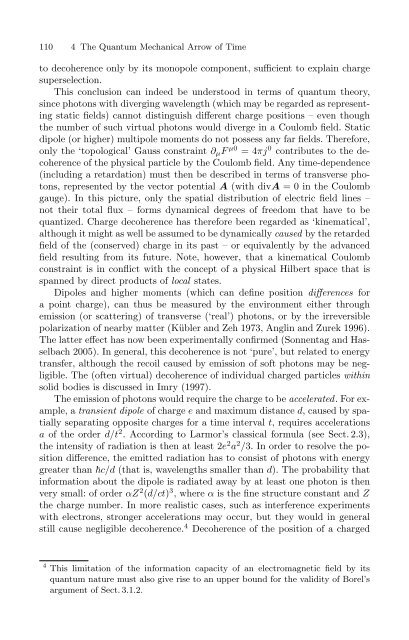The Physical Basis of The Direction of Time (The Frontiers ...
The Physical Basis of The Direction of Time (The Frontiers ...
The Physical Basis of The Direction of Time (The Frontiers ...
Create successful ePaper yourself
Turn your PDF publications into a flip-book with our unique Google optimized e-Paper software.
110 4 <strong>The</strong> Quantum Mechanical Arrow <strong>of</strong> <strong>Time</strong><br />
to decoherence only by its monopole component, sufficient to explain charge<br />
superselection.<br />
This conclusion can indeed be understood in terms <strong>of</strong> quantum theory,<br />
since photons with diverging wavelength (which may be regarded as representing<br />
static fields) cannot distinguish different charge positions – even though<br />
the number <strong>of</strong> such virtual photons would diverge in a Coulomb field. Static<br />
dipole (or higher) multipole moments do not possess any far fields. <strong>The</strong>refore,<br />
only the ‘topological’ Gauss constraint ∂ µ F µ0 =4πj 0 contributes to the decoherence<br />
<strong>of</strong> the physical particle by the Coulomb field. Any time-dependence<br />
(including a retardation) must then be described in terms <strong>of</strong> transverse photons,<br />
represented by the vector potential A (with divA = 0 in the Coulomb<br />
gauge). In this picture, only the spatial distribution <strong>of</strong> electric field lines –<br />
not their total flux – forms dynamical degrees <strong>of</strong> freedom that have to be<br />
quantized. Charge decoherence has therefore been regarded as ‘kinematical’,<br />
although it might as well be assumed to be dynamically caused by the retarded<br />
field <strong>of</strong> the (conserved) charge in its past – or equivalently by the advanced<br />
field resulting from its future. Note, however, that a kinematical Coulomb<br />
constraint is in conflict with the concept <strong>of</strong> a physical Hilbert space that is<br />
spanned by direct products <strong>of</strong> local states.<br />
Dipoles and higher moments (which can define position differences for<br />
a point charge), can thus be measured by the environment either through<br />
emission (or scattering) <strong>of</strong> transverse (‘real’) photons, or by the irreversible<br />
polarization <strong>of</strong> nearby matter (Kübler and Zeh 1973, Anglin and Zurek 1996).<br />
<strong>The</strong> latter effect has now been experimentally confirmed (Sonnentag and Hasselbach<br />
2005). In general, this decoherence is not ‘pure’, but related to energy<br />
transfer, although the recoil caused by emission <strong>of</strong> s<strong>of</strong>t photons may be negligible.<br />
<strong>The</strong> (<strong>of</strong>ten virtual) decoherence <strong>of</strong> individual charged particles within<br />
solid bodies is discussed in Imry (1997).<br />
<strong>The</strong> emission <strong>of</strong> photons would require the charge to be accelerated . For example,<br />
a transient dipole <strong>of</strong> charge e and maximum distance d, caused by spatially<br />
separating opposite charges for a time interval t, requires accelerations<br />
a <strong>of</strong> the order d/t 2 . According to Larmor’s classical formula (see Sect. 2.3),<br />
the intensity <strong>of</strong> radiation is then at least 2e 2 a 2 /3. In order to resolve the position<br />
difference, the emitted radiation has to consist <strong>of</strong> photons with energy<br />
greater than c/d (that is, wavelengths smaller than d). <strong>The</strong> probability that<br />
information about the dipole is radiated away by at least one photon is then<br />
very small: <strong>of</strong> order αZ 2 (d/ct) 3 ,whereα is the fine structure constant and Z<br />
the charge number. In more realistic cases, such as interference experiments<br />
with electrons, stronger accelerations may occur, but they would in general<br />
still cause negligible decoherence. 4 Decoherence <strong>of</strong> the position <strong>of</strong> a charged<br />
4 This limitation <strong>of</strong> the information capacity <strong>of</strong> an electromagnetic field by its<br />
quantum nature must also give rise to an upper bound for the validity <strong>of</strong> Borel’s<br />
argument <strong>of</strong> Sect. 3.1.2.



![arXiv:1001.0993v1 [hep-ph] 6 Jan 2010](https://img.yumpu.com/51282177/1/190x245/arxiv10010993v1-hep-ph-6-jan-2010.jpg?quality=85)


![arXiv:1008.3907v2 [astro-ph.CO] 1 Nov 2011](https://img.yumpu.com/48909562/1/190x245/arxiv10083907v2-astro-phco-1-nov-2011.jpg?quality=85)








![arXiv:1002.4928v1 [gr-qc] 26 Feb 2010](https://img.yumpu.com/41209516/1/190x245/arxiv10024928v1-gr-qc-26-feb-2010.jpg?quality=85)
![arXiv:1206.2653v1 [astro-ph.CO] 12 Jun 2012](https://img.yumpu.com/39510078/1/190x245/arxiv12062653v1-astro-phco-12-jun-2012.jpg?quality=85)
